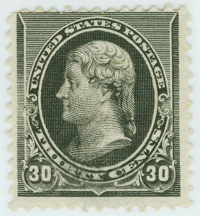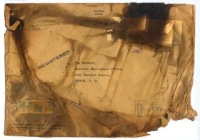The perfect stamp for collecting
by Bruce Dangremond
16th of March 2010
Four months after the attack on Fort Sumter, and the beginning of the Civil War, a new series of stamps was issued in August of 1861. This series was issued expressly to “prevent the fraudulent use of the large quantity of stamps remaining unaccounted for, in the hands of postmasters in the disloyal states” (ref 1).
The three-cent stamp saw the most use of any stamp in the series because at the time three cents was the postal rate per ½ oz on letters traveling not over 3,000 miles (ref 2). Most letters of that time fit this description. The Civil War, whose end wasn’t until 1865, also caused a large increase in correspondence between soldiers, their family members and friends. It has been estimated (ref 3) that approximately two billion of these three-cent stamps were printed including those grilled and special printings that were issued in later years.
Collectively these stamps are referred to as type number A25 in the Identifier Section of the Scott Catalogue (ref 4) and features the portrait of George Washington facing left. The numeral “3” appears in the top right and left corners with the words “US POSTAGE” centered over the portrait. In the lower left corner is the letter “U” and in the lower right corner is the letter “S”. The words “THREE CENTS” is centered and below the portrait. The color is generally described as “rose” although various shades from pink to brown red exist.
This stamp continues to provide a bonanza of material for those who pursue philatelic interests. It was printed using different ink formulas resulting in various shades of color from pink to brown red. Many covers with this stamp affixed are of historical significance. They deal with many aspects of life in the 1860’s: political, commercial, family life, soldier and prisoner of war experiences. Many varieties of this stamp exist because the Post Office Department was experimenting with grills in an effort to better obliterate stamps from 1867 to 1868. From 1861 to 1868 was also a period of time when many Post Offices were commonly producing what are now known as “fancy cancels”. The stamp was issued seven months before the end of the pony express. Covers bearing this stamp and pony express markings exist, as well as the markings of other overland express companies. This stamp and its covers also were transported by steamship and railway. Many stamps and covers are so marked. There were a total of 26 plates used in its production, thereby offering ample plating material. In my option, there is no other single US stamp that offers more varied collecting opportunities. The stamp remains relatively inexpensive, compared to others in the series, owing to its abundant production. And, this stamp continues to provide collectors with philatelic “surprises” and “rewards”.
Below is a list, by Scott Number, of all known examples of the A25 with the estimated number of stamps issued (ref 4).
| Scott # | Color | Grill |
Perf. | No. Issued | Year |
| 64 | Pink | none | 12 | 100,000 | 1861-62 |
| 64a | pigeon blood | none | 12 | unknown | " |
| 64b | rose pink | none | 12 | unknown | " |
| 65 | rose | none | 12 | 1,782,000,000 | " |
| 65b | rose | none | 12, laid paper | unknown | " |
| 66P | lake | none | color proof | unknown | n/a |
| 74P | scarlet | none | color proof | unknown | n/a |
| 79 | rose | type “A” all over | 12 | 50,000 | 1867 |
| 82 | rose | type “B” 18 x 15 mm | 12 | unknown | " |
| 83 | rose | type “C” 13 x 16 mm | 12 | 300,000 | " |
| 85 | rose | type “D” 12 x 14 mm | 12 | 500,000 | " |
| 85C | rose | type “Z” 11 x 14 mm | 12 | 100,000 | " |
| 88 | rose | type “E” 11 x 13 mm | 12 | 3,000,000 | " |
| 94 | rose | type “F” 9 x 13 mm | 12 | 225,000,000 | 1868 |
| 104 | brown red | none | 12, hard white paper | 565 | n/a |
1 The United States Postage Stamps of the 19th Century by Lester G. Brookman , Volume II
2 Postal Act of 1855, April 1.
3 The United States Postage Stamps of the 19th Century by Lester G. Brookman , Volume II
4 SCOTT 2000 Specialized Catalogue of U.S. Stamps & Covers.


